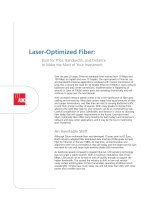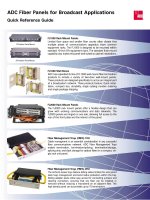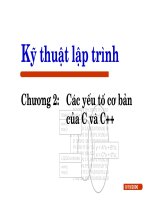Tài liệu Laser-Optimized Fiber: Built for Price, Bandwidth, and Distance to Make the Most of Your Investment doc
Bạn đang xem bản rút gọn của tài liệu. Xem và tải ngay bản đầy đủ của tài liệu tại đây (276.66 KB, 4 trang )
Laser-Optimized Fiber:
Built for Price, Bandwidth, and Distance
to Make the Most of Your Investment
Over the past 25 years, Ethernet standards have evolved from 10 Mbps and
100 Mbps to Gigabit and now 10 Gigabit. The rapid growth of Internet use
and bandwidth-intensive applications combined with routine transmission of
large files is driving the need for 10 Gigabit Ethernet (10GbE) in many network
backbone and data center connections. Implementation is happening all
around us. Sales of 10GbE switch ports are increasing dramatically, and will
continue to grow over the next decade.
With increased network speeds comes a rise in the significance of fiber optic
cabling and connectivity. Most data centers today have equal amounts of fiber
and copper terminations, and fiber links are vital to carrying backbone traffic
to and from a large number of sources. With many grades to choose from,
selecting the right fiber type for your network can be an overwhelming task.
Careful consideration of price, bandwidth, and distance is critical to choosing
fiber today that will support requirements in the future. Laser-optimized
50µm multimode fiber offers many benefits for both today's and tomorrow's
network and data center applications, and it may be the key to maximizing
your investment.
An Inevitable Shift
Although 50µm multimode fiber was developed 10 years prior to 62.5µm,
North America adopted fiber distributed data interface (FDDI)-grade 62.5µm
fiber for Ethernet in the late 1980s. At that time, connectorization and
alignment were not as controlled as they are today, and the larger-core 62.5µm
was ideal for use with larger light-emitting diode (LED) transmitters.
As backbone speeds increased to Gigabit Ethernet, LED signaling technology
was no longer a viable solution. With a maximum modulation rate of 622
Mbps, LEDs could not be turned on and off quickly enough to support the
higher bandwidth. This caused the industry to shift to low-cost vertical-
cavity surface emitting laser (VCSEL) transmitters operating at 850nm (short
wavelength). VCSELs have much faster rise and fall times than LEDs with more
power and a smaller spot size.
Laser-Optimized Fiber: Built for Price, Bandwidth, and Distance to Make the Most of Your Investment
Page 2
Unfortunately, the use of VCSELs can cause differential
mode delay (DMD), an effect that happens when the
laser beam launched into a small area of the fiber's core
splits into several modes of light traveling at different
speeds. DMD ultimately causes the transmission pulse
to spread out, which reduces the ability of the receiver
to properly identify the signal and therefore reduces
transmission capacity (see Figure 1).
Figure 1. The Effect of DMD on Transmission
Because a larger fiber core has more modes of light
excited and more modal dispersion, VCSELs do
not perform as well with 62.5µm multimode fiber
as they do with 50µm. So when low-cost 850nm
VCSEL transmission technology was introduced
for higher speeds, the industry moved away from
62.5µm fiber. However, as the 10 Gigabit Ethernet
standard developed, it became apparent that even
50µm multimode fiber could not take full advantage
of the VCSEL point-like precision technology to run
10GbE over a 300-meter distance. As a result, fiber
manufacturers began manufacturing laser-optimized
50µm multimode fiber, which is now the most
recommended fiber type for new installations and
upgrades.
Truly Advanced Technology
What exactly is laser-optimized fiber and what does it
mean? It's important to acknowledge that the term
"laser optimized" is not a marketing ploy or misnomer.
Also referred to as OM3 fiber, laser-optimized fiber is
specifically designed, developed, and tested for effective
use with 850nm VCSELs.
With standard fiber, defects and variations in the fiber
core can affect the angle and speed that a light pulse
can travel. This effect is the refractive index profile of
the material, which is calculated as the ratio of the
speed of light in a vacuum to the speed of light through
the material. For example, the refractive index of a
vacuum is 1.0, while air is slightly higher than 1.0, and
glass ranges from 1.45-1.48. The higher the refractive
index, the slower the speed of light through that media.
In laser-optimized multimode fiber, manufacturers
have removed impurities and carefully graded the
index of refraction of the fiber core to enhance VCSEL
transmission. By carefully controlling the refractive
index profile, DMD is reduced and the several modes of
light are able to travel at similar speeds thus increasing
the modal bandwidth. This prevents the transmission
pulse from spreading out, and as a result, the receiver
can accurately detect the signal over longer distances,
therefore maximizing bandwidth (see Figure 2).
Figure 2. Laser Optimized Fiber Reduces DMD
for Reliable Transmission
Laser-optimized 50µm fiber provides a much higher
modal bandwidth than standard 50µm or 62.5µm
fiber. A 10GbE signal at a wavelength of 850nm is only
guaranteed for 26 meters on standard 62.5µm fiber and
for 86 meters on standard 50µm fiber. Standard laser-
optimized 50µm fiber can support 10GbE to 300m,
which is the distance specified under TIA standards as
the minimum distance for backbone cabling. Higher-
grade laser-optimized 50µm multimode fiber can even
support 10GbE beyond the standard to distances up to
550 meters.
Laser-optimized (OM3) 50µm fiber is now well accepted
in the industry, and many cable and connectivity
manufacturers offer a variety of 50µm fiber optic
products. Laser-optimized 50µm fiber has also been
accepted and specified by all major standard bodies,
most notably under IEEE 802.3 and ANSI/TIA/EIA 568-B.
Following is a table of IEEE GbE and 10GbE standards
with related fiber types and bandwidths/distances (see
Table 1).
As shown in Table 1, standard 62.5µm and 50µm only
support 10GbE to 300m using wavelength division
multiplexing (WDM) electronics, which uses four laser
sources at 2.5 Gigabit each and is cost prohibitive.
With 62.5µm fiber making up much of the installed
base, the IEEE is exploring ways to run 10 Gigabit
Ethernet over 300 meters of 62.5µm fiber with the use
of a singlemode laser source. The proposed standard,
however, is slow to develop and does not currently
appear as cost effective as upgrading to laser-optimized
50µm multimode fiber, the benefits of which are many.
Laser-Optimized Fiber: Built for Price, Bandwidth, and Distance to Make the Most of Your Investment
Cladding
Core
10 Gbps
850 nm Laser
Detector
Cladding
Core
10 Gbps
850 nm Laser
Detector
Laser Optimized MM fibers control DMD to support 10 Gb/s up
to 300 or 550 meters with low cost 850 nm serial applications.
10 Gb/s reliable transmission, design flexibility
Cladding
Core
10 Gbps
850 nm Laser
Detector
Cladding
Core
10 Gbps
850 nm Laser
Detector
Laser Optimized MM fibers control DMD to support 10 Gb/s up
to 300 or 550 meters with low cost 850 nm serial applications.
10 Gb/s reliable transmission, design flexibility
Laser-Optimized Fiber: Built for Price, Bandwidth, and Distance to Make the Most of Your Investment
Page 3
Fiber Type Gigabit Link @ 850nm
Laser IEEE 802.3z
1000BASE-SX
Gigabit Link @ 1310nm
Laser IEEE 802.3z
1000BASE-LX
10 Gigabit Link @ 850nm
Laser IEEE 802.3ae
10GBASE-SR
10 Gigabit Link @ 1310
CWDM Laser IEEE
802.3ae 10GBASE-LX4*
62.5/125 µm multimode fiber
062/OM1 300m 550m 86m 300m
50/125 µm multimode fiber
050/OM1 550m 550m 86m 300m
50E/OM2 750m 600m 150m 300m
50U/OM3 970m 600m 300m 300m
5U5/OM3 1040m 600m 550m 300m
*LX4 standard uses Wide Wave Division Multiplexing scheme
Table 1. Fiber Type and Distance per IEEE Standards
With the same percentage of terminations as copper,
fiber optic cabling and connectivity is a significant part
of the data center. Fiber backbone links are also the
most critical links because they carry data to and from a
large number of sources, including telecommunication
rooms and the outside world. As emerging technologies
continue to be layered onto the network, laser-
optimized 50µm fiber will be key to maximizing your
investment in all LAN applications.
Laser-optimized 50µm multimode fiber is ideal for use
in any LAN infrastructure or data center application,
including campus backbone, riser, storage, or horizontal
connections. Laser-optimized 50µm fiber is available in
several grades and construction types to meet a variety
of applications and cost benefits. For example, ADC's
TrueNet
®
Structured Cabling solutions includes three
grades of laser-optimized multimode fiber – Enhanced,
Ultra 300, and Ultra 550, which support 10GbE to
150m, 300m, and 550m respectively. Each of these
laser-optimized grades is also available in a variety of
constructions including outside plant, indoor/outdoor,
plenum, riser, and armored.
Because fiber optic cabling is backwards compatible,
but not forwards, it's critical to choose fiber today that
will support current and future bandwidth requirements.
Laser-optimized 50µm fiber is compatible with legacy
LED signaling technology while enabling migration to
higher speeds. In other words, you can install laser-
optimized fiber today for use with slower data rates,
and when the need for more bandwidth arises, you only
need to upgrade electronics to VCSEL-based transceivers
for GbE or 10GbE. As discussion begins surrounding
next-generation Ethernet like 40Gbps or 100Gbps, it's
expected that laser-optimized 50µm multimode fiber
will also support those speeds through higher-grade
fibers or WDM schemes.
When you consider the total investment to upgrade or
deploy a network or data center, the cost difference
between fiber types is minimal. Singlemode fiber
electronics, however, can cost two to three times
more than multimode electronics. In addition, it is
anticipated that the cost per port of 10GbE over fiber
will continue to decrease. So choosing laser-optimized
50µm multimode fiber just makes sense – it's the one
fiber type that allows for affordable electronics while
reaching all areas of your LAN, providing the most
flexibility and future growth for your data center and
backbone infrastructure.
Maximizing Your Investment
Web Site: www.adc.com
From North America, Call Toll Free: 1-800-366-3891 • Outside of North America: +1-952-938-8080
Fax: +1-952-917-3237 • For a listing of ADC’s global sales office locations, please refer to our Web site.
ADC Telecommunications, Inc., P.O. Box 1101, Minneapolis, Minnesota USA 55440-1101
Specifications published here are current as of the date of publication of this document. Because we are continuously
improving our products, ADC reserves the right to change specifications without prior notice. At any time, you may
verify product specifications by contacting our headquarters office in Minneapolis. ADC Telecommunications, Inc.
views its patent portfolio as an important corporate asset and vigorously enforces its patents. Products or features
contained herein may be covered by one or more U.S. or foreign patents. An Equal Opportunity Employer
102263AE 4/06 Original © 2006 ADC Telecommunications, Inc. All Rights Reserved
WHITE PAPER
Conclusion
As you set out to choose a fiber type for your LAN infrastructure and data center connections, it's
important to recognize that within the rank of multimode fiber are higher performance grades known
as laser-optimized multimode fiber. Gigabit and 10 Gigabit Ethernet speeds in the backbone are a
reality today, and so is this remarkable advanced fiber technology. Laser-optimized 50µm multimode
fiber offers the following benefits over other types of fiber:
• Offers the most bandwidth with cost-effective 850nm VCSELs
• Ensures reliable transmission through advanced technologies
• Thoroughly recognized and specified by standards bodies
• Enables easy migration to Gigabit and 10 Gigabit network speeds
• Ideal for use in any LAN or data center fiber connection
• Available in several products, grades, and cable constructions
It is important to carefully examine your network and evaluate the distances and bandwidths required
now and in the future. To maximize your investment, you must choose the correct type and grade of
fiber to support future needs.









